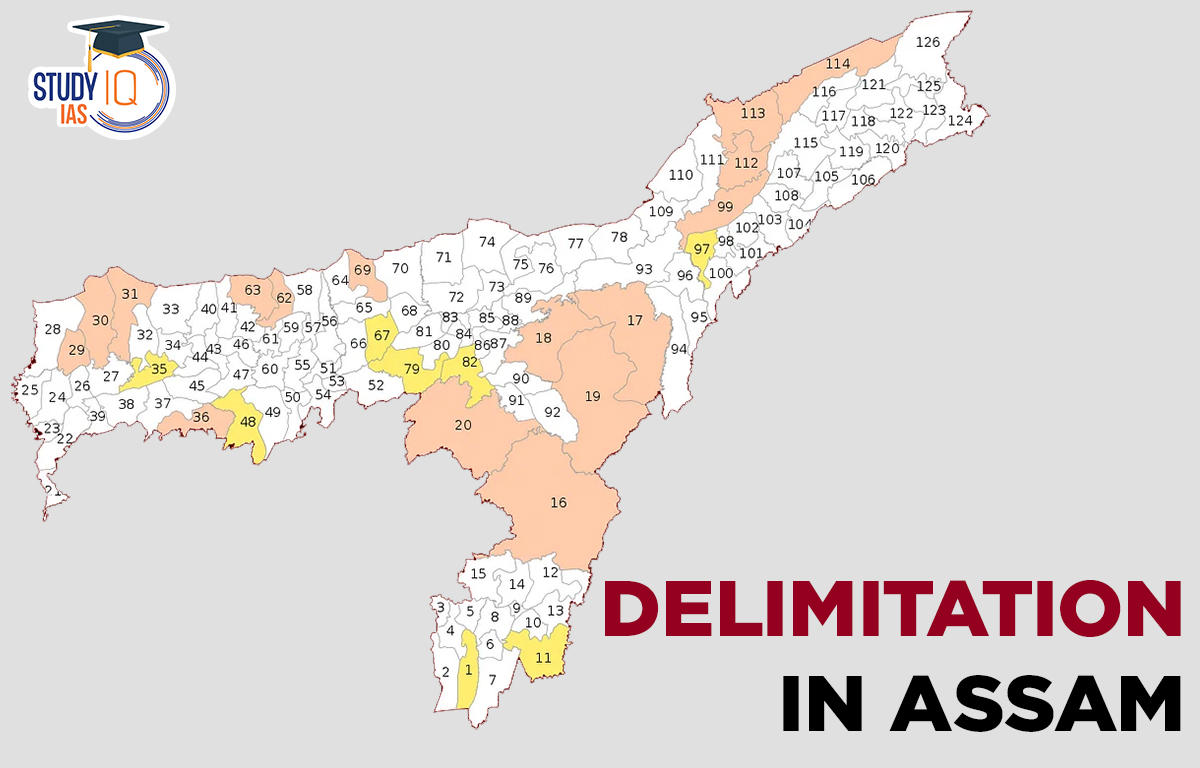Table of Contents
Context: The Election Commission of India has begun the process of delimitation of Assembly and Parliamentary constituencies in Assam.
About the Delimitation in Assam
- The delimitation process will be based on Census data from 2001. The last delimitation of constituencies in Assam was done in 1976 on the basis of the 1971 Census.
What is Delimitation?
- Delimitation is the act of redrawing boundaries of Lok Sabha and state Assembly seats to represent changes in population.
- Objectives of Delimitation:
- To provide equal representation to equal segments of a population.
- Fair division of geographical areas so that one political party doesn’t have an advantage over others in an election.
- To follow the principle of “One Vote One Value”.
- Constitutional provisions:
- Article 82: This provides the Parliament with the authority to enact a Delimitation Act after every Census.
- Article 170: This provides for the States to get divided into territorial constituencies as per the Delimitation Act after every Census.
- Who carries out delimitation?
- Delimitation is carried out by an independent Delimitation Commission, appointed by the Government of India under provisions of the Delimitation Commission Act.
About the Delimitation Commission
- The Delimitation Commission in India is a high-power body whose orders have the force of law.
- Composition: The Delimitation Commission is appointed by the President of India includes following members:
- Retired Supreme Court judge
- Chief Election Commissioner
- Respective State Election Commissioners
- Functions:
- To determine the number and boundaries of constituencies to make population of all constituencies nearly equal.
- To identify seats reserved for Scheduled Castes and Scheduled Tribes, wherever their population is relatively large.
- In case of difference of opinion among members of the Commission, the will of majority prevails.
- Powers:
- The Constitution mandates that the Commission’s orders are final and cannot be questioned before any court as it would hold up an election indefinitely.
- The copies of its orders are laid before the House of the People and the State Legislative Assembly concerned, but no modifications are permissible therein by them.
- How is delimitation supposed to be carried out?
- After the delimitation commission determines the number and boundaries of constituencies, the draft proposals of the Commission are published for public feedback.
- The Commission also holds public sittings. After hearing the public, it considers objections and suggestions, and carries out changes, if any, in the draft proposal.
- The final order is published in the Gazette of India and the State Gazette concerned and comes into force on a date specified by the President.
- History of delimitations in India:
- In the history of the Indian republic, Delimitation Commissions have been set up four times — 1952, 1963, 1973 and 2002 under the Acts of 1952, 1962, 1972 and 2002.
- There was no delimitation after the 1981, 1991 and 2001 Censuses. However, the 2002 Act did not make any changes in total Lok Sabha seats or their apportionment between various states.
- The 2002 Act also left out a few states including Assam, Arunachal Pradesh, Nagaland and Manipur from the exercise due to “security risks.”
- The central government reconstituted the Delimitation Commission for these four states as well as the union territory of Jammu and Kashmir on 6 March 2020.
Current Position of Delimitation
- The last delimitation exercise that changed the state-wise composition of the Lok Sabha was completed in 1976 and done on the basis of the 1971 census (more than half a century ago at this point).
- The reasons for not having more frequent delimitation processes:
- Several states feared that states that took little interest in population control could end up with a greater number of seats in the Parliament due to the population provision of delimitation.
- The fear of losing meaningful political representation was especially great in the southern states which not only had had greater success in controlling populations but also economically developed.
- To allay these fears, the Constitution was amended during Indira Gandhi’s Emergency rule in 1976 to suspend delimitation until 2001.
- Another amendment postponed this until 2026. It was hoped that the country would achieve a uniform population growth rate by this time.


 Current Affairs 29th April 2024 for UPSC...
Current Affairs 29th April 2024 for UPSC...
 Towards Green Growth, Impact of Climate ...
Towards Green Growth, Impact of Climate ...
 Editorial of the day (29th Apr): Israel ...
Editorial of the day (29th Apr): Israel ...

















